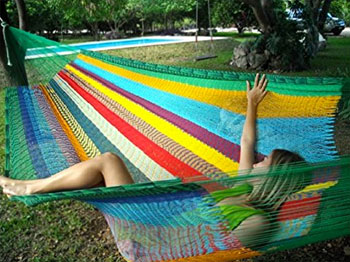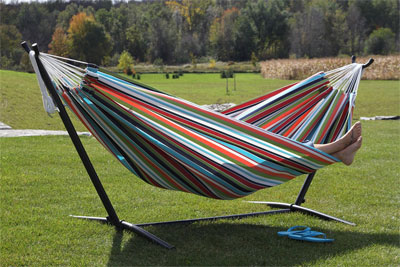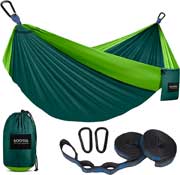As you probably already guessed, there is not just one style of hammock. In fact, there are several different types of sleeping hammocks you can get – all with different features and purposes.
First of all, there are rope hammocks and fabric hammocks.
If you plan to use your hammock outside, consider these factors: fabric types work better in cooler climates and dry faster, while the rope version is better in warmer climates.
TIP: Many people who use them for sleeping will choose the fabric style due to the fact that they don’t want to have a criss-cross pattern all over their bodies when they wake up.

Secondly, some include spreader bars while others do not.

There are hammocks that have wooden spreader bars at both ends of the bed, essentially spreading the fabric or netting into a wide flat surface. Many poolside varieties have this design. They are more commonly associated with flipping over (unexpectedly), and they also don’t conform as well to a person’s body, due to the fact that they are spread out flat.
You can also choose the type that doesn’t include the spreader bars that typically have a less-structured look. These include Mayan, Brazilian, Nicaraguan and camping hammocks. They wrap around a person’s body since they don’t have the spreader bars, and they don’t flip when you are laying flat in them (pretty essential if you plan on sleeping in one!).
TIP: Although poolside hammocks tend to use a more durable fabric (due to sun exposure) and appear more welcoming (since they are spread open like a bed), they are not usually recommended for sleeping in on a regular basis.
Bottom Line: What are the Best Types of Hammocks for Sleeping?
In short, if you are looking for a sleeping hammock, you want to choose one without the spreader bars to ensure a better night’s sleep. Also, you probably want to avoid potential rope marks after laying for long periods of time. Therefore, it’s better to avoid the Mayan or Nicaraguan styles. They are constructed with either thin string or cotton cords.
By the way, a great feature of the Brazilian and camping styles is that they are space-saving. Without the spreader bars, they can fully compact when not in use. Thus, if you plan to use one in a small room, porch or deck, they won’t completely overtake the space.
Also Consider a Hammock Stand:
If you don’t plan on hanging your hammock from two trees, a support structure or strong beams in the walls of your house, a stand can be quite handy. They usually aren’t that expensive, and many can be quickly disassembled for travel, storage, etc…
Some hammock stands are also designed as “space-saving”. Therefore, they take up a small footprint where you set them up, especially when used with a compact camping or Brazilian Hammock (even if it’s a 2-person version!).
TIP: If you want a hammock stand, you can save a good amount of money by purchasing a hammock + stand package. When purchased separately, you can often pay 1.5 – 2 times as much!
And lastly, if you want a camping hammock for… well, camping, check out the video below. It shows 10 different types of hammocks that are compact, lightweight, comfortable and great for sleeping. My favorite is the ENO camping hammock (made by Eagle Nest Outfitters).




